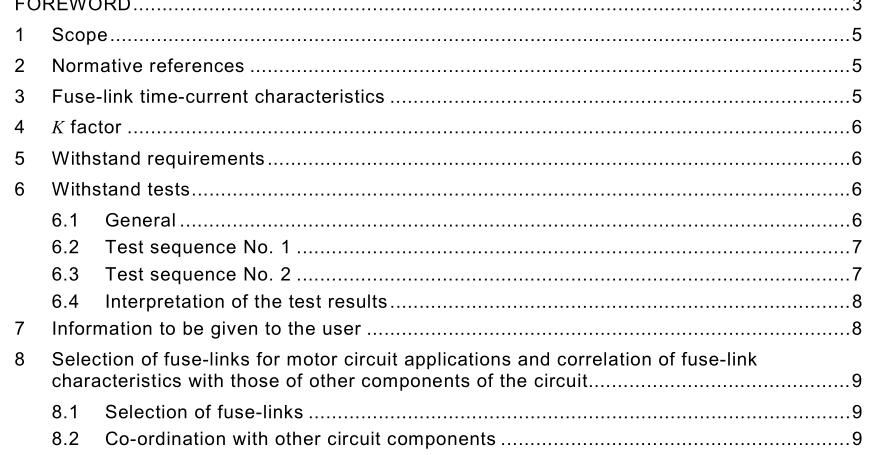IEC 60644-2009 pdf Specification for high-voltage fuse-links for motor circuit applications

4 K factor Factor which defines an overload characteristic to which the fuse-link may be repeatedly subjected under specified motor starting conditions, and other specified motor-operating overloads, without deterioration. For the purpose of this specification, the value of K is chosen at 1 0 s. Unless otherwise stated by the fuse-link manufacturer, it is valid from 5 s to 60 s, for a frequency of starts up to six per hour and for not more than two consecutive starts. For conditions different from those specified above, for example where service conditions involve inching, plugging or more frequent starts, the manufacturer should be consulted. The overload characteristic is obtained by multiplying the current on the pre-arcing characteristic by K (less than unity). 5 Withstand requirements The performance of a fuse-link for motor circuit applications is in general determined by the following criteria: – to withstand without deterioration starting pulses in rapid succession due for example to abnormal conditions, such as those occurring during commissioning of the equipment; – to withstand without deterioration a large number of motor starts in normal service conditions. This standard therefore specifies two sequences of tests representative of these conditions: 1 00 cycles corresponding to abnormal service conditions; 2 000 cycles corresponding to normal service conditions. It is expected that a fuse-link which passes these tests will have a good behaviour during a satisfactory life duration.
8 Selection of fuse-links for motor circuit applications and correlation of fuse- link characteristics with those of other components of the circuit 8.1 Selection of fuse-links The fuse-link is inserted into the motor circuit that the fuse-link is intended to protect. Some ratings of the fuse-links (e.g. rated voltage and rated breaking current) are therefore dependent on the system and others (e.g. rated current) are dependent on the motor. The ability to withstand repetitive starting conditions is an important factor. When selecting a fuse-link for a given motor circuit application, due regard should be paid to the K factor, which should be applied to the pre-arcing time-current characteristic of the fuse-link to take account of these starting conditions. The usual concept of rated current, based upon the ability of a fuse-link to carry a given current continuously without exceeding a specified temperature rise, is usually of secondary importance where the motor is started direct-on-line. The fuse-link for such applications is normally chosen by reference to the paragraphs above.
- ISO IEC 27050-4-2021 pdf Information technology — Electronic discovery — Part 4: Technical readiness
- ISO IEC 27036-1-2021 pdf Cybersecurity — Supplier relationships — Part 1: Overview and concepts
- ISO IEC 27013-2021 pdf Information security, cybersecurity and privacy protection — Guidance on the integrated implementation of ISO/IEC 27001 and ISO/IEC 20000-1
- ISO IEC 26580-2021 pdf Software and systems engineering — Methods and tools for the feature- based approach to software and systems product line engineering
- ISO IEC 24735-2021 pdf Information technology — Office equipment — Method for measuring digital copying productivity
- ISO IEC 24711-2021 pdf Information technology — Office equipment — Method for the determination of ink cartridge yield for colour inkjet printers and multi- function devices that contain printer components
- ISO IEC 23544-2021 pdf Information Technology — Data centres — Application Platform Energy Effectiveness (APEE)
- ISO IEC 23510-2021 pdf Information technology — 3D printing and scanning — Framework for an Additive Manufacturing Service Platform (AMSP)
- ISO IEC 23127-1-2021 pdf Information technology — Learning, education, and training — Metadata for facilitators of online learning — Part 1: Framework
- ISO IEC 23126-2021 pdf Information technology for learning, education and training — Ubiquitous learning resource organization and description framework
- IEC TS 63217-2021 pdf Utility-interconnected photovoltaic inverters – Test procedure for over voltage ride-through measurements
- IEC 62705-2014 pdf Nuclear power plants – Instrumentation and control important to safety – Radiation monitoring systems (RMS): Characteristics and lifecycle
- IEC 60938-1-2021 pdf Fixed inductors for electromagnetic interference suppression – Part 1: Generic specification
- IEC 60092-2007 pdf ELECTRICAL INSTALL ATIONS IN SHIPS – OPERATION OF EL ECTRICAL INSTALLATIONS
- ISO IEC 26580-2021 pdf Software and systems engineering — Methods and tools for the feature- based approach to software and systems product line engineering
- BS ISO IEC 15420-2009 pdf Information technology一 Automatic identification and data capture techniques EAN/UPC bar code symbology specification
- BS IEC 60860-2014 pdf Radiation protection instrumentation一 Warning equipment for criticality accidents
- BS ISO IEC 19762.5-2008 pdf Information technology一 Automatic identification and data capture (AIDC) techniques – Harmonized vocabulary Part 5: Locating systems
- ISO IEC 24711-2021 pdf Information technology — Office equipment — Method for the determination of ink cartridge yield for colour inkjet printers and multi- function devices that contain printer components
- ISO IEC 24735-2021 pdf Information technology — Office equipment — Method for measuring digital copying productivity